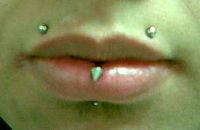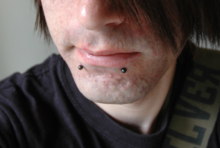- Lip piercing
-
Lip Piercing 
Nicknames Snakebites, Monroe, etc. Location upper, lower or middle lip Healing 6 to 8 weeks. A lip piercing is a type of body piercing that penetrates the lips or the area surrounding the lips, which can be pierced in a variety of ways.
Approximate healing times for most lip piercings are between 1 to 2 months, however there is a possibility of serious infections developing if the piercing is not taken care of.[1] After healing is complete, other jewelry may be used. After this time, some scar tissue may be present, but the fistula is normally fully developed and mostly healed. Aftercare consists of saline soaks two to three times daily. Soaking the wound for three to five minutes with a weak saline solution softens any blood and lymph discharge attached to the jewelry. Using a q-tip removes excess matter from the site. Afterward, one should slowly turn the jewellery through the piercing, rinse with saline solution to flush the inside of the wound and remove any matter remaining in and around the piercing. Diluted mouthwash can also be used after meals to help remove debris and flush the piercing and is recommended by some practitioners.
Initial jewelry is usually a labret stud or a captive bead ring, manufactured from high-grade surgical stainless steel, implant-grade titanium, or similar lightweight and inert metal. No matter which type of jewelry is used, the jewelry's diameter and length will be intentionally over sized to allow room for initial swelling. After healing, the jewelry can be replaced with a closer-fitting piece.
A home-made saline solution made from one-fourth teaspoon of all natural pink or gray non-iodized sea salt and one cup of hot distilled or filtered water is a common way to heal a lip piercing and avoid infection. This solution can be used to rinse out the mouth after eating (or the mouth can be rinsed with non-alcoholic, non-antimicrobial mouth wash) and to soak the outside of the piercing. Anything with alcohol, peroxide, iodine, or any strong soaps should be avoided because they may irritate the fresh piercing, and cause additional swelling and trauma during the healing process. Also using things like peroxide, iodine, teatree oil, conventional antibacterial soap, or dish soap can damage or kill the skin in and around the piercing, extending the healing process. The ornament should be periodically cleansed to prevent bacterial plaque accumulation.[2]
Contents
Types
Lip piercings can be placed anywhere around the mouth, but the surface of the lip is not typically pierced itself, except for horizontal lip piercings and canine bites. Piercings in specific positions have certain names. Monroe piercings, for example, are labret studs worn on the upper lip where Marilyn Monroe had her famous mole. Medusa piercings go through the center of the upper lip (the philtrum), perpendicular to the tissue. Labret piercings are pierced with a labret stud and can pierced in the center or off-center. A variation of this is the lowbret, a lower labret. Vertical labret piercings go through the center of the bottom lip, parallel to the tissue. The variation is called the vertical lowbret, which starts inside the mouth between the lower lip and the teeth and travels straight down, exiting on the lower edge of the jawline. Horizontal lip piercings are very rare, and include a horizontal bar on the lower lip that goes through the lip surface. There is also the dahlia piercing, which are by the creases of the mouth.
History and culture
Precolumbian cultures of South America historically used lip piercing called Tembetá. Lip piercing continues to be practiced by many people, the most well-known of which are certain African tribes, who wear large decorative lip plates or discs, usually in the lower lip.
In contemporary society, lip piercings are relatively uncommon. In a study among Israeli young-adults, 4.3% had present or past body piercing (not included earlobe, lip or intra-oral piercing), and 5.7%, 6.2% and 15.7% had present or past lip piercing, body tattooing and intra-oral piercing, respectively.[3]
See also
- Body piercing
- Body piercing jewelry
- Tongue frenulum piercing, another oral piercing
- Tongue piercing, another oral piercing
- Monroe piercing, a type of lip piercing
- Medusa piercing, a type of lip piercing
- Labret piercing, a type of lip piercing
- Lip plate, a type of lip piercing
References
- ^ http://news.bbc.co.uk/2/hi/health/3201389.stm
- ^ Zadik Yehuda, Becker Tal, Levin Liran (January 2007). "Intra-oral and peri-oral piercing". J Isr Dent Assoc 24 (1): 29–34, 83. PMID 17615989.
- ^ Levin Liran, Zadik Yehuda, Becker Tal (December 2005). "Oral and dental complications of intra-oral piercing". Dent Traumatol 21 (6): 341–3. doi:10.1111/j.1600-9657.2005.00395.x. PMID 16262620. http://www3.interscience.wiley.com/journal/118672805/abstract?CRETRY=1&SRETRY=0. Retrieved 2008-07-16.
External links
Body piercing General piercing topics Contemporary piercing practices · Scalpelling · Stretching · Play piercing · Pocketing · Surface piercing · Ear piercing gunJewelry (materials) Barbell · Claw · Captive bead ring · Flesh tunnel · Plug · Prince's wand · Spiral · Stud · Nose chain · Nipple shieldEar piercings Facial and oral piercings Body piercings Unisex genital or anal piercings Female genital piercings Christina · Clitoris · Clitoral hood · Triangle · Fourchette · Isabella · Labia · Nefertiti · Princess AlbertinaMale genital piercings Ampallang · Apadravya · Hafada · Foreskin · Deep shaft · Dolphin · Dydoe · Frenum (Frenum ladder) · Lorum · Magic cross · Prince Albert · Reverse Prince Albert · Transscrotall
Categories:- Body modification
- Facial piercings
- Lips
Wikimedia Foundation. 2010.


